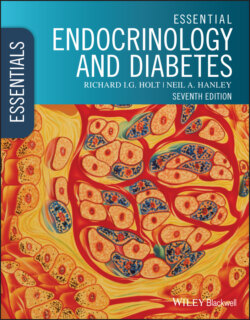Читать книгу Essential Endocrinology and Diabetes - Richard I. G. Holt - Страница 31
Endocrine disorders
ОглавлениеThe chapters in Part 2 largely focus on organ‐specific endocrinology and associated endocrine disorders. Diabetes and obesity in Part 3 has now become its own specialized branch of endocrinology. Nevertheless, it is possible to regard all endocrine abnormalities as too much, too little or disordered production of hormone. Some clinical features occur because of compensatory overproduction of hormones. For example, Addison disease is a deficiency of cortisol from the adrenal cortex (Chapter 6), which reduces negative feedback on ACTH production at the anterior pituitary. ACTH rises and stimulates melanocytes in the skin to increase pigmentation, especially in unusual locations, which is a striking sign of Addison disease.
Imbalanced hormone production may occur when a particular enzyme is missing because of a genetic defect. For example, in congenital adrenal hyperplasia, lack of 21‐hydroxylase prevents adequate cortisol synthesis (Chapter 6). Other pathways within adrenocortical cells remain intact, leading to excess production of sex steroids that masculinize aspects of the female body. Endocrine disorders may also arise from abnormalities in hormone receptors or downstream signalling pathways. The commonest example is type 2 diabetes, which is characterized, at least in part, by resistance to insulin action in target tissues (Chapter 13).
For endocrine organs under regulation by the hypothalamus and anterior pituitary, the associated disorders can also be categorized according to site. When disease is located in the end organ it is termed ‘primary’. When the end organ is affected because of an upstream problem in the anterior pituitary (either under‐activity or over‐activity) it is termed secondary, while in tertiary disease, the pathology resides in the hypothalamus.
Tumours affect all organs and tissues. In endocrinology, these tumours are most commonly sporadic and benign but they may over‐secrete hormones resulting in organ‐specific syndromes. These are described in the appropriate chapters of Part 2. Endocrine tumourigenesis may also affect multiple endocrine organs as unusual clinical syndromes. These are described in Chapter 10.
